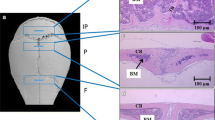Abstract
Background and aims
Heterotopic ossification (HO) is a pathological bone formation process in which ectopic bone is formed in soft tissue. The formation of bone depends on the expression of the osteoblast phenotype. Earlier studies have shown conflicting results on the expression of phenotype markers of cells originating from HO and normal bone. The hypothesis of the present study is that cells from HO show an altered expression of osteoblast-specific phenotype markers compared to normal osteoblasts. The aims of the study were to further characterize the expression of osteoblast phenotypemarkers and to provide a comparison with other study results.
Patients and methods
Using an in vitro technique, reverse transcription polymerase chain reaction (RT-PCR), real-time PCR and immunohistochemistry, we compared the phenotype gene expression (type I collagen, alkaline phosphatase, Cbfa-1, osteocalcin) of osteoblasts from resected HO and normal bone (iliac crest).
Results
Cells from HO expressed the osteoblast phenotype (type I collagen, alkaline phosphatase) but were characterized by a depleted osteocalcin expression. The expression of Cbfa-1 (osteocalcin transcription gene) showed a large variety in our study. Preoperative radiotherapy had no effect on phenotype expression in cells from HO.
Conclusion
Our results provide a characterization of cells originating from HO and support the thesis of an impaired osteoblast differentiation underlying the formation of HO. The transcription axis from Cbfa-1 to osteocalcin could be involved in the pathogenesis of HO.



Similar content being viewed by others
References
Garland DE (1991) A clinical perspective on common forms of acquired heterotopic ossification. Clin Orthop 263:13–29
Brooker AF, Bowerman JW, Robinson RA, Riley LH Jr (1973) Ectopic ossification following total hip replacement. Incidence and a method of classification. J Bone Joint Surg Am 55:1629–1632
Moore TJ (1993) Functional outcome following surgical excision of heterotopic ossification in patients with traumatic brain injury. J Orthop Trauma 7:11–14
Pakos EE, Ioannadinis JP (2004) Radiotherapy vs. nonsteroidal anti-inflammatory drugs for the prevention of heterotopic ossification after major hip procedures: a meta-analysis of randomized trials. Int J Radiat Oncol Biol Phys 60:888–895
Sarafis KA, Karatzas GD, Yotis CL (1999) Ankylosed hips caused by heterotopic ossification after traumatic brain injury: a difficult problem. J Trauma 46:104–109
Pape HC, Marsh S, Morley JR, Krettek C, Giannoudis PV (2004) Current concepts in the development of heterotopic ossification. J Bone Joint Surg Br 86:783–787
Gennarelli TA (1988) Heterotopic ossification. Brain Inj 2:175–178
Chalmers J, Gray DH, Rush J (1975) Observations on the induction of bone in soft tissues. J Bone Joint Surg Br 57:36–45
Trentz OA, Hoerstrup SP, Sun LK, Bestmann L, Platz A, Trentz O (2003) Osteoblasts response to allogenic and xenogenic solvent dehydrated cancellous bone in vitro. Biomaterials 24:3417–3426
Handschin AE, Trentz OA, Hoerstrup SP, Kock HJ, Wanner GA, Trentz O (2005) Effect of low molecular weight heparin (dalteparin) and fondaparinux (Arixtra) on human osteoblasts in vitro. Br J Surg 92:177–183
Sell S, Gaissmaier C, Fritz J, Herr G, Esenwein S, Kusswetter W, Volkmann R, Wittkowski KM, Rodemann HP (1998) Different behavior of human osteoblast-like cells isolated from normal and heterotopic bone In vitro. Calcif Tissue Int 62:51–59
Chauveau C, Devedjian J-C, Blary M-C, Delecourt C, Hardouin P, Jeanfils J, Broux O (2004) Gene expression in human osteoblastic cells from normal and heterotopic ossification. Exp Mol Pathol 76:37–43
Tenenbaum HC (1990) Cellular origins and theories of differentiation. In: Hall BK (ed) Bone, vol I. The osteocyte. Telford Press, New Jersey, pp 41–69
Lian JB, Stein GS, Stein JL, van Wijnen AJ (1998) Osteocalcin gene promoter: unlocking the secrets for regulation of osteoblast growth and differentiation. J Cell Biochem Suppl 30/31:62–72
Ducy P, Desbois C, Boyce B, Pinero G, Story B, Dunstan C, Smith E, Bonadio J, Goldstein S, Gundberg C, Bradley A, Karsenty G (1996) Increased bone formation in osteocalcin-deficient mice. Nature 382:448–452
Chenu C, Colucci S, Grano M, Zigrino P, Barattolo R, Zambonin G, Baldini N, Vergnaud P, Delmas PD, Zallone AZ (1994) Osteocalcin induces chemotaxis, secretion of matrix proteins, and calcium-mediated intracellular signaling in human osteoclast-like cells. J Cell Biol 127:1149–1158
Wilkinson JM, Stockley I, Hamer AJ, Barrington NA, Eastell R (2003) Biochemical markers of bone turnover and development of heterotopic ossification after total hip arthroplasty. J Orthop Res 21:529–534
Trentz OA, Handschin AE, Bestmann L, Hoerstrup SP, Trentz OL, Platz A (2005) Influence of brain injury on early posttraumatic bone metabolism. Crit Care Med 33:399–406
Kaysinger K, Ramp WK, Lang GJ, Gruber HE (1997) Comparison of human osteoblasts and osteogenic cells from heterotopic bone. Clin Orthop Relat Res 342:181–191
Banarjee C, McCabe LR, Choi JY, Hiebert SW, Stein JL, Stein GS, Lian JB (1997) Runt homology domain proteins in osteoblast differentiation: AML3/CBFA1 is a major component of a bone-specific complex. J Cell Biochem 66:1–8
Komori T, Yagi H, Nomura S, Yamaguchi A, Sasaki K, Deguchi K, Shimizu Y, Bronson RT, Gao YH, Inanda M, Sato M, Okamoto R, Kitamura Y, Yoshiki S, Kishimoto T (1997) Targeted disruption of Cbfa1 results in a complete lack of bone formation owing to maturational arrest of osteoblasts. Cell 89:755–764
Siggelkow H, Rebenstorff K, Kurre W, Niedhardt C, Engel I, Schulz H, Atkinson MJ, Hüfner M (1999) Development of the osteoblast phenotype in primary human osteoblasts in culture: comparison with rat calvaria cells in osteoblast differentiation. J Cell Biochem 75:22–35
Gilbert L, He X, Farmer P, Rubin J, Drissi H, van Wijnen AJ, Lian JB, Stein GS, Nanes M (2002) Expression of the osteoblast differentiation factor RUNX2 (Cbfa-1/AML3/Pebp2aA) is inhibited by tumor necrosis factor-a. J Biol Chem 277:2695–2701
Author information
Authors and Affiliations
Corresponding author
Rights and permissions
About this article
Cite this article
Handschin, A.E., Egermann, M., Wedler, V. et al. A comparative analysis of phenotype expression in human osteoblasts from heterotopic ossification and normal bone. Langenbecks Arch Surg 391, 376–382 (2006). https://doi.org/10.1007/s00423-005-0021-5
Received:
Accepted:
Published:
Issue Date:
DOI: https://doi.org/10.1007/s00423-005-0021-5




